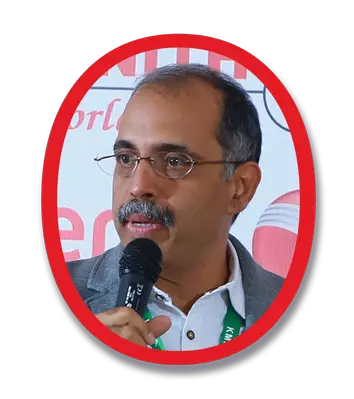20 quotes from PWI To kick-start 2019 - The Noel D'Cunha Sunday Column
Quotes that bring focus on print
04 Jan 2019 | By Noel D'Cunha
Future of books
The books are going to grow. When I talk to American publishers, I get to know that the book market has grown by 3% to 4%in the last year. It is an opportunity for the Indian printers because of the developments in China. If the publisher, printer and the government unite, then Indian print will benefit from it.

Anil Rego of Brilliant Printers in Bengaluru
The relentless jostling of rates in digital printing
In this war of rates, it is difficult to completely understand the mathematics. I realised that the principles applied by the offset printer are not being applied by a digital printer. The method of costing in offset is definitely more structured.

Jagdish Bajaj of PrintXpress in Bengaluru
Print in India
In India, like any other industry, the printing industry is evolving and gearing up for a massive change both in terms of technology of placing ink on paper and building up the capacities for catering to the requirements of high quality, faster turn-around time and at affordable pricing. The technologies for putting ink on paper are also merging, giving birth to hybrid technologies for supporting the requirements of “on the fly variable data printing” in the form of barcodes, and images and texts.

Ravi Joshi of United Multicolour Printers in Pune
President, All India Federation of Master Printers
Growth of labels
Globally the fastest growing region is Asia-Pacific, driven by India and China. Although growth rates here have slowed, we are still seeing up to 8% growth in all label applications in India and 6% in China, which contrasts with under 2% growth in the developed markets of Western Europe and North America. The biggest pressure-sensitive label application is for VIP/logistics and industrial sectors such as auto and durables, and in prime labels, food and drink, followed by household chemicals, cosmetics and pharma.

Lisa Milburn of Tarsus
Making packages flirt
I think the packaging is like a living human being. It’s all about attracting customers. I call it the flirting phase. This is something we have done very well in the packaging industry, but there are still challenges.
A lot can be achieved in the flirting phase of packaging. Kinder Joy is a historic example of how packaging can flirt with kids. In edible products, Ferroro flirts with the customers. But how do we do it in categories like detergents? In Big Bazaar, we started offering sugar-free with detergents. I am not sure why, but the scheme took off. The sales increased from 7% to 15% and stabilised at 10-11%, which is a big deal considering the competition.
Today, the trend of ‘unboxing’, which promises the customers the joy of opening a box, is picking up. We experimented with our walnut packs, where we gave a small pin to crack open the walnuts easily. This became the selling point of the pack.

Sadashiv Nayak, CEO at Big Bazaar
Walking out of a deal if it does not work in favour of your business
We have declined many print jobs if it is not sustainable. If any company has to grow, they have to take into account their current working as well as future plans. If you are not able to function with a margin of at least 10% you will not be able to survive for long, leave alone grow.

Nitin Shah of Award Offset Printers & Packaging
President, BMPA
A good leadership style for our industry – do you wield the whip when you should be encouraging creativity? Or is it remote control?
I think there is no right and wrong and it depends upon the nature of the business. For example, if I was only running the newspaper business, I could manage to run it on my own. But I oversee six diverse businesses. I need a team or else I don’t think I have a chance to succeed because my competitors have a specialised focus. Plus I need to see if the six businesses are inter-connected or no. For instance, if I have the print business which includes commercial with publishing kind of operations, it is manageable. But if it includes packaging, and security printing, and security cards, then it is almost impossible for one person to run such a vast and complex business.

Gautham Pai of Manipal Technologies
Concept selling not managed or structured better in print operations?
As long as the print owner calls his client to take the order, the salesman becomes irrelevant. Maybe only 10-15% companies have good salesmen who pitch for the print product and these salesmen are able to explain why a company should buy his product or explain the difference between the products. Rest of the 85% business is managed on a phone call and decided based on the pricing and relationship.

SM Ramprasad of Fujifilm
Today the industry has become a far more competitive space than it was two years ago?
Yes, and on top of that, the oil prices have gone up, which has led to most input costs going up such as inks, solvents, and PET films. Further, internationally pulp prices have gone up leading to increase in paperboard prices. So there has been a series of the constant input pricing change. Just when we are talking to customers for one increase, there’s a second increase announced and now recently a third increase. This causes a huge lag effect in getting our costs passed on which is really putting a lot of pressure on us to maintain margins.

Saket Kanoria of TCPL
Publishing business
Publishing is like start-ups, we have around 300 titles, we are certain that all 300 will not do well. Even if just 20% of it does well, it’s good for us. Of the rest, 30-40% would be midsize, and 10-20% would definitely fall below expectation. That’s a challenge. We cannot ensure that all 100% of our projects do well. It would be ideal, but not realistic.

Sanjiv Gupta, CFO & COO, Penguin Random House India
Packaging market in India, especially labels
It is getting bigger and bigger. The purchasing power of every citizen has increased in India. We have seen packaging enter the interiors of India, and everything that wasn’t within reach earlier is now easily available. Also within the Indian market, there are new Indian companies which are established with a strong belief that as an Indian company, they have to make things in India. All this is, and will, trigger growth in the label, carton, and flexible industry.
On a very conservative side, the label market is estimated to be around Rs 3,000-crore. A 15% growth means Rs 450-crore of label jobs are there for the taking. All that the brand owners need is quality label printers with capacities to produce and grab the jobs.

Aaditya Kashyap of Marks Group
Why packaging is a specialised business
Be it pharma, FMCG, cosmetic, or wine and spirit, among others, all are demanding the best in packaging, and just-in-time. Hence, there’s a need for not only quality printing, but automation that permits quick turnarounds. Good packaging printers which are in the industry for over 25 years are adopting the latest in technology. That’s the first: bring in automation. The second is costing. Commercial printers apply the same costing method for packaging that they deploy for commercial jobs. In packaging, the cost of the raw material cost is 65% whereas in commercial it is 30-35%. Such printers who do packaging jobs suffer the most when there are rejections. Three to four rejections can wipe off your entire year’s profits.

Nitin Shah of Awards Offset Printers & Packaging
Why top photographers, top painters, publishers in India trust Jak Printers?
I totally confuse them. They don’t know what the hell we are doing. Apart from confusing the customer, we start reading about what they want. A customer may be looking at the reproduction that his daughter has painted or the silver lining around the lamps and so he is seeking a metallic silver in the final job or a menu card that can be read in the dark. It’s like a doctor who diagnoses and then prescribes. A printer is like a doctor. Try to understand what the customer’s pain point is. Is it colour? Or finishing? Or packing? The printer needs to be a doctor. A printer needs to help the customer realise that printers are superheroes.

Khushru Patel of Jak Printers
Status of printing industry
Even though we claim printing industry as the third largest industry in the world, it is positioned only in the 26th place in productivity and turnover because of its inherent inefficiencies

Bhuvnesh Seth of Replika Press
Create complex solutions for better earnings
Today we must focus on the 600-million middle-class buyers who have high aspirations and demand better quality products. One must also keep in mind that the genetic imprint of an Indian buyer is to look for high quality at the lowest possible cost. Low cost, durability and vibrant colours are what an average Indian buyer demands.
Unique and out-of-the-box thinking and proactive approach towards finding a solution for your client is the way forward. We must aspire to become the client’s partner rather than just a supplier
Amalgamate different processes – augmented reality, LED, EL, offset, screen, digital. Create complex solutions for better earnings.

Amit Shah of Spectrum Scan
The draft food safety regulations and the manner in which the framework is being chalked out
The FSSAI regulations are very complex and not thought through. What is not banned in developed countries like Europe, USA and Australia are being banned in India. This is a major concern as product safety could be at a huge risk if incorrect packaging material is used.

Vinay Nalawade, director, Parakh Group
Three trends in packaging
We are seeing smart packaging on the horizon, but it’s still to come in a big way. But in terms of value appeal, I think the appeal of the carton is growing and it is one of the trends which is continuing. It is not a new trend, but it is continuing in a bigger way.
The second trend is automation by customers. So the product packing, which was happening say 100 units per minute, now it’s going up to 200 to 500 to 700. Companies like Colgate or Unilever are packing their soaps and toothpaste at a very high speed of 600-700 units per minute. So I think that automation also helps in engineering the packaging product.

Ramesh Kejriwal of Parksons Packaging
Need for automation
Automating processes, streamlining operations and minimising wastage is Singhania’s mantra. Our idea is to automate the operations in such a way that the company can “turnaround any job in 24 hours”. Work-in-progress material lying on the shopfloor is a waste of money. Five years down the line, I want to see my printing plant run like a manufacturing line. Today, every customer every job is yesterday’s job. So we have to be equipped.

Nitin Singhania of Singhania Printers
Transformative differentiation in the corrugated sector
The corrugation industry is going through a good phase and growing. Probably it is one of the rare products which have lasted for over a hundred years of their life cycle and I don’t see any replacement for this. Plus the government initiative of banning the plastic is going to benefit the corrugation industry. I believe, digital printing will find its place in corrugation too. At the moment the only constraint with digital printing is the cost, both in terms of capital expenditure and the finished products that you will be selling to the customer. Over a period, I feel, the technology will evolve and we will have lower equipment costs and manufacturing costs.
Sanjay Chhajed, of Pune-based Paack In India
Raw material price hike – absorbing or passing on the hike to customers
We are printers and not central bank to absorb any costs. The government is increasing the price of petroleum products on a daily basis. So we also pass on the burden to the next station as no one can absorb it. While doing it on a daily basis is not viable, we have to look at it at regular intervals. Most of the customers do understand as we do not operate in an insulated world.

Narendra Paruchuri of Pragati Offset











 See All
See All